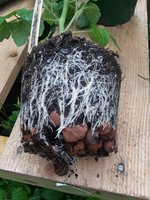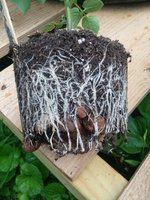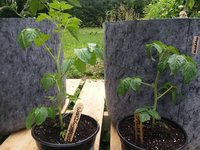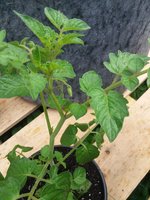I have no idea if it would specifically work on your pepper problem but calcium supplements for BER in peppers is a good plan. BER is just not enough calcium in the fruits. I grow the san marzanos too. It's a big problem with them, isn't it?
For BER on tomates and zucchinis our prevention plan starts when we transplant. We put 1/4 cup of crushed eggshells in the hole before planting.
Then if we see problems we pick any fruits showing any signs of the condition (even just a little) and throw them in the compost. If they are showing the slightest sign of BER, they're already dead.
Then we mulch around the plants if we can. Pull weeds, drop them on top, grass clippings, anything to keep moisture levels consistent.
Then we mix the milk, and water it onto the plants ye olde watering can style. Do this in the evening after the sun is well past it's zenith and it's markedly starting to cool off but it's not night yet. I like around 7PM for this. Don't do this in full sun/midday.
Instead of milk you can use any bioavailable calcium supplement. I have used slurries of human calcium citrate supplements in water before. The trick is to make it as bioavailable as possible without any additions.
(These are about humans but it still applies;
https://www.ncbi.nlm.nih.gov/pubmed/8602592
https://www.globalhealingcenter.com/natural-health/types-of-calcium-supplements/
https://www.dairynutrition.ca/nutrients-in-milk-products/calcium/calcium-and-bioavailability)
Repeat a few times over a couple weeks.
A few more fruits usually still die out but the following flush of fruit post-treatment usually shows marked improvements.
This is just what we do, mind you. There's all sorts of info about how to mist the plants and when to do it and how much to use, and how much water and making sure your PH and NPK are right and stuff... But I'm a little too lazy for all that and just do it old fashioned with a watering can after the air cools down. We also know we have calcium issues in our soil. We get BER every year. I'm thinking of dumping a big bag of bone meal into the gardens for next year if I can find one at a fair price as a longer-term solution.
Here's some info on BER treatment with calcium.
http://extension.uga.edu/publications/detail.html?number=C938&title=Blossom-End Rot and Calcium Nutrition of Pepper and Tomato
https://www.gardeners.com/how-to/blossom-end-rot/5354.html
https://bonnieplants.com/library/conquer-blossom-end-rot/
https://www.gardeningknowhow.com/ed...uash-blossom-end-rot-causes-and-treatment.htm
https://www.motherearthnews.com/organic-gardening/blossom-end-rot-prevention-and-treatment-zbcz1502
And some stuff on foliar feeding!
https://en.wikipedia.org/wiki/Foliar_feeding
https://www.maximumyield.com/the-dos-and-donts-of-foliar-feeding/2/3418
https://drearth.com/learning-center/projects/foliar-feeding/
For BER on tomates and zucchinis our prevention plan starts when we transplant. We put 1/4 cup of crushed eggshells in the hole before planting.
Then if we see problems we pick any fruits showing any signs of the condition (even just a little) and throw them in the compost. If they are showing the slightest sign of BER, they're already dead.
Then we mulch around the plants if we can. Pull weeds, drop them on top, grass clippings, anything to keep moisture levels consistent.
Then we mix the milk, and water it onto the plants ye olde watering can style. Do this in the evening after the sun is well past it's zenith and it's markedly starting to cool off but it's not night yet. I like around 7PM for this. Don't do this in full sun/midday.
Instead of milk you can use any bioavailable calcium supplement. I have used slurries of human calcium citrate supplements in water before. The trick is to make it as bioavailable as possible without any additions.
(These are about humans but it still applies;
https://www.ncbi.nlm.nih.gov/pubmed/8602592
https://www.globalhealingcenter.com/natural-health/types-of-calcium-supplements/
https://www.dairynutrition.ca/nutrients-in-milk-products/calcium/calcium-and-bioavailability)
Repeat a few times over a couple weeks.
A few more fruits usually still die out but the following flush of fruit post-treatment usually shows marked improvements.
This is just what we do, mind you. There's all sorts of info about how to mist the plants and when to do it and how much to use, and how much water and making sure your PH and NPK are right and stuff... But I'm a little too lazy for all that and just do it old fashioned with a watering can after the air cools down. We also know we have calcium issues in our soil. We get BER every year. I'm thinking of dumping a big bag of bone meal into the gardens for next year if I can find one at a fair price as a longer-term solution.
Here's some info on BER treatment with calcium.

http://extension.uga.edu/publications/detail.html?number=C938&title=Blossom-End Rot and Calcium Nutrition of Pepper and Tomato
https://www.gardeners.com/how-to/blossom-end-rot/5354.html
https://bonnieplants.com/library/conquer-blossom-end-rot/
https://www.gardeningknowhow.com/ed...uash-blossom-end-rot-causes-and-treatment.htm
https://www.motherearthnews.com/organic-gardening/blossom-end-rot-prevention-and-treatment-zbcz1502
And some stuff on foliar feeding!
https://en.wikipedia.org/wiki/Foliar_feeding
https://www.maximumyield.com/the-dos-and-donts-of-foliar-feeding/2/3418
https://drearth.com/learning-center/projects/foliar-feeding/


 80-20 methods and all that.
80-20 methods and all that.

 but we needed some wood ash for the chickens and it was a green day for a burn. Will be out early to water tomorrow.
but we needed some wood ash for the chickens and it was a green day for a burn. Will be out early to water tomorrow.



